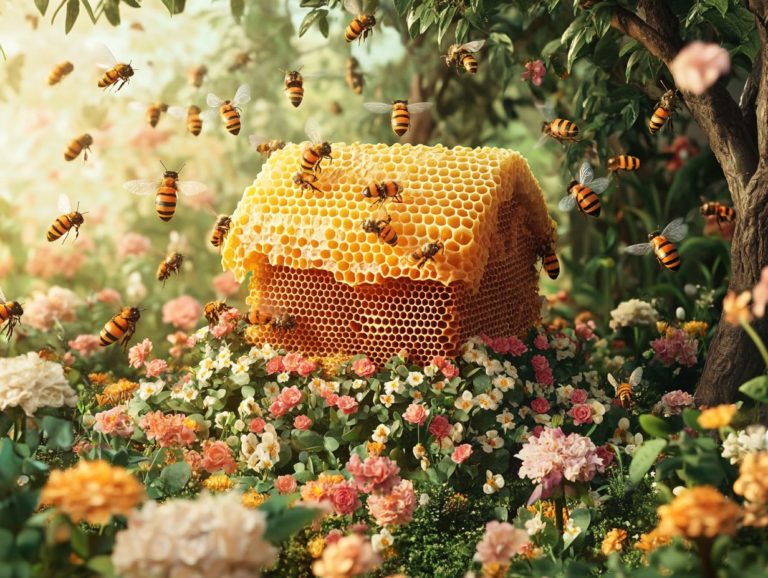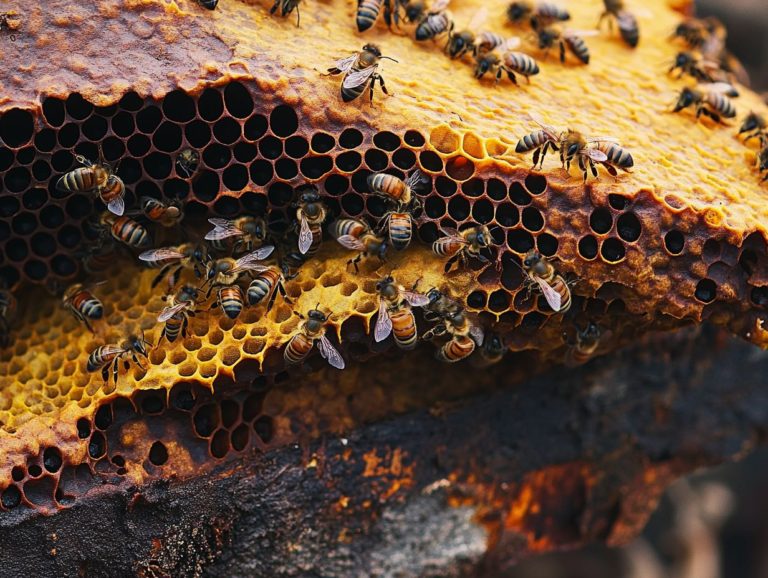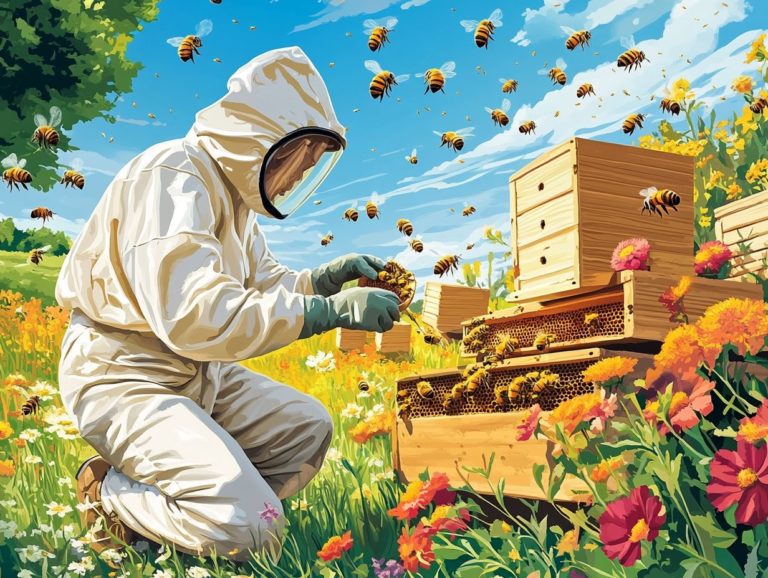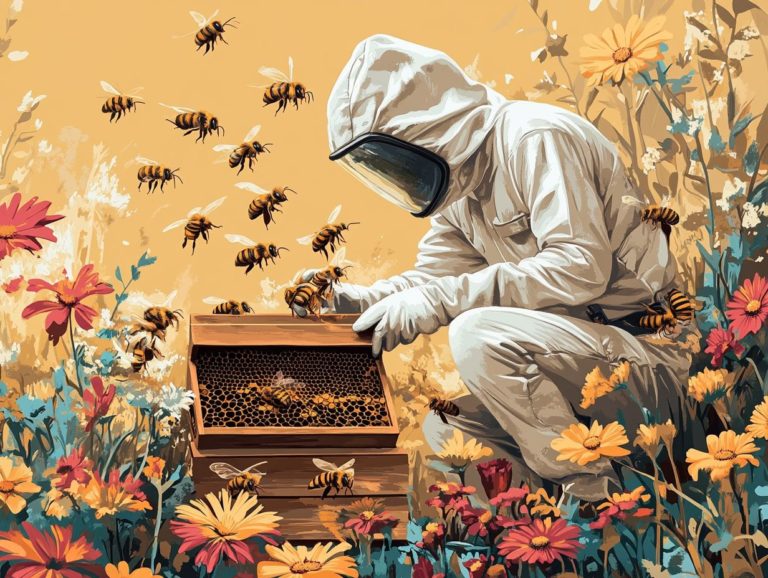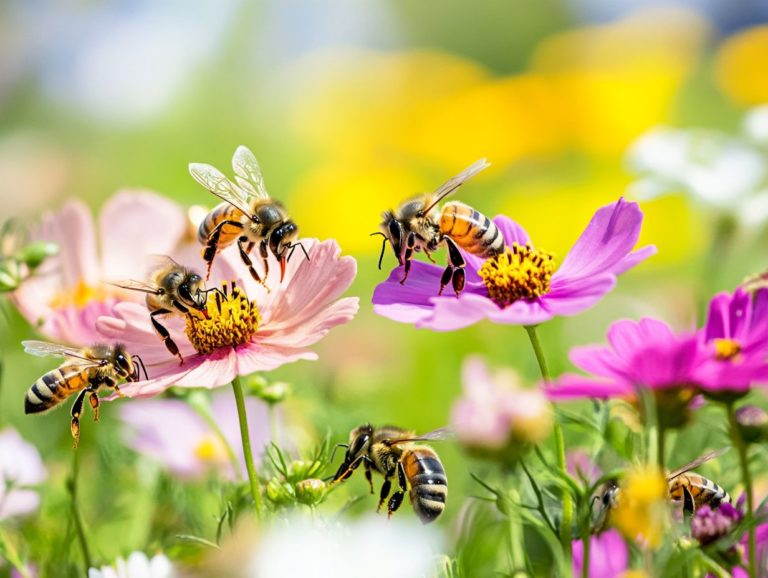How to Promote Hive Stability
Maintaining hive stability is crucial for the health and productivity of your bee colony. Utilizing a proper hive stand is vital to prevent instability. An unstable hive can spell trouble, leading to decreased honey production, increased aggression, and the potential loss of your queen.
This article delves into what hive stability truly means and why it s a matter of utmost importance. You ll uncover practical strategies for promoting stability, such as conducting regular hive inspections, providing proper nutrition, and implementing effective pest control.
Learn how to spot signs of instability and discover effective interventions to revitalize struggling hives. Immerse yourself in this knowledge to ensure your bees continue to thrive and produce abundantly, even when dealing with heavy supers!
Contents
Key Takeaways:
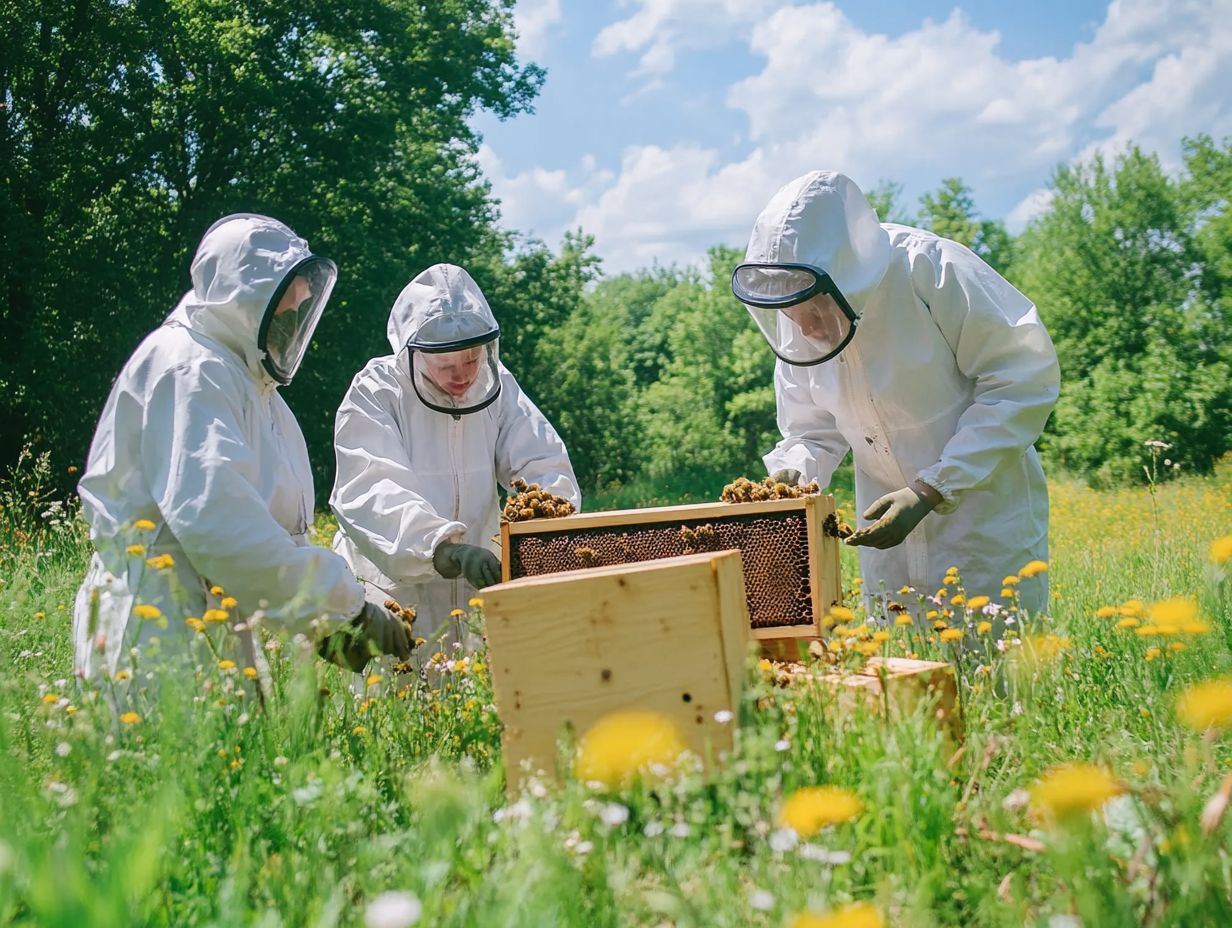
- Regular hive inspections are crucial in maintaining hive stability, as they allow for early detection and prevention of potential issues.
- Providing proper nutrition, controlling pests and diseases, and managing population size are key factors in promoting hive stability.
- Signs of an unstable hive include decreased honey production, increased aggression in bees, and queen supersedure or absconding. Taking action to address these signs can help improve hive stability.
What Is Hive Stability?
Hive stability is crucial in your beekeeping journey. It profoundly impacts the health and productivity of your bee colonies.
A solid foundation for your hives affects their ability to bear weight, especially when handling heavy supers.
A well-designed hive stand offers a comfortable working height. It also reduces risks associated with damp ground or vegetation blocking the hive entrance.
This attention to detail fosters enhanced honey production and boosts the overall performance of your hives.
Why Is Hive Stability Important?
Hive stability is crucial for several reasons that enhance your beekeeping success. For you as a beekeeper, a stable hive is fundamental for effectively managing your colonies.
It allows for consistent honey production and minimizes disruptions during hive inspections. When your hives are stable, they can better support the weight of heavy supers, reduce stress factors that might impact bee behavior, and help maintain optimal population sizes. Prioritizing stability can transform your beekeeping experience!
How Can You Promote Hive Stability?
To promote hive stability effectively, you should adopt various strategies and best practices, including the use of strong hive stands and secure assembly techniques.
Regular hive inspections are essential. Don t wait until problems arise act now to ensure your bees thrive! They allow you to assess the health of your colonies and identify potential issues, such as pests and diseases, that could threaten the stability of your hive environment. Make sure to wear your bee suit for protection during these checks.
Providing proper nutrition through sugar syrup and ensuring adequate ventilation can greatly enhance hive stability. This, in turn, leads to healthier bees and improved honey production, making your beekeeping efforts all the more rewarding. Consider using foundation-filled frames to maximize efficiency.
1. Regular Hive Inspections
Regular hive inspections are essential to your success as a beekeeper, playing a pivotal role in maintaining the stability of your hive. By routinely assessing the health and activity of your bees, you can swiftly identify issues such as diseases, pests, or imbalances in brood frames. If these problems are left unchecked, they could jeopardize the integrity of your entire hive.
Inspections also give you the opportunity to evaluate the hive’s design and its stability on the platform, making sure everything remains secure and conducive to optimal bee activity.
These inspections not only encourage a proactive approach to beekeeping but also empower you to take timely action when necessary. During your evaluations, pay close attention to the condition of the brood frames; a healthy and consistent brood pattern is a strong indication of a vigorous queen and a productive colony.
Keep an eye out for signs of pest infestations, like varroa mites or wax moths, and assess the overall health of the hive, including food stores and moisture levels. By regularly monitoring these aspects, you can prevent minor issues from escalating into serious threats, ultimately ensuring that your hive thrives and remains resilient.
2. Proper Nutrition
Providing proper nutrition to your bee colony is crucial for fostering hive stability and maximizing honey production. You can utilize sugar syrup, especially during those lean forage periods, to ensure your bees have the energy they need to thrive. By maintaining a supply of drawn comb and foundation-filled frames, you support your bees ability to store vital resources, encouraging robust colony growth and vigorous bee activity key ingredients for a stable hive.
Incorporating protein supplements like pollen patties can significantly enhance brood development and contribute to the overall health of your bees, ensuring that your colony remains strong. Additionally, varying nutritional sources by introducing vitamins and minerals can boost their immunity and resilience against pests and diseases.
Understanding the specific dietary needs throughout the changing seasons and adapting your feeding strategies will enable you to create an environment that nurtures healthy, productive bees. By prioritizing nutrition, you not only sustain the strength of your hive but also make a significant impact on your honey yield, paving the way for a more sustainable and profitable beekeeping venture.
3. Controlling Pests and Diseases
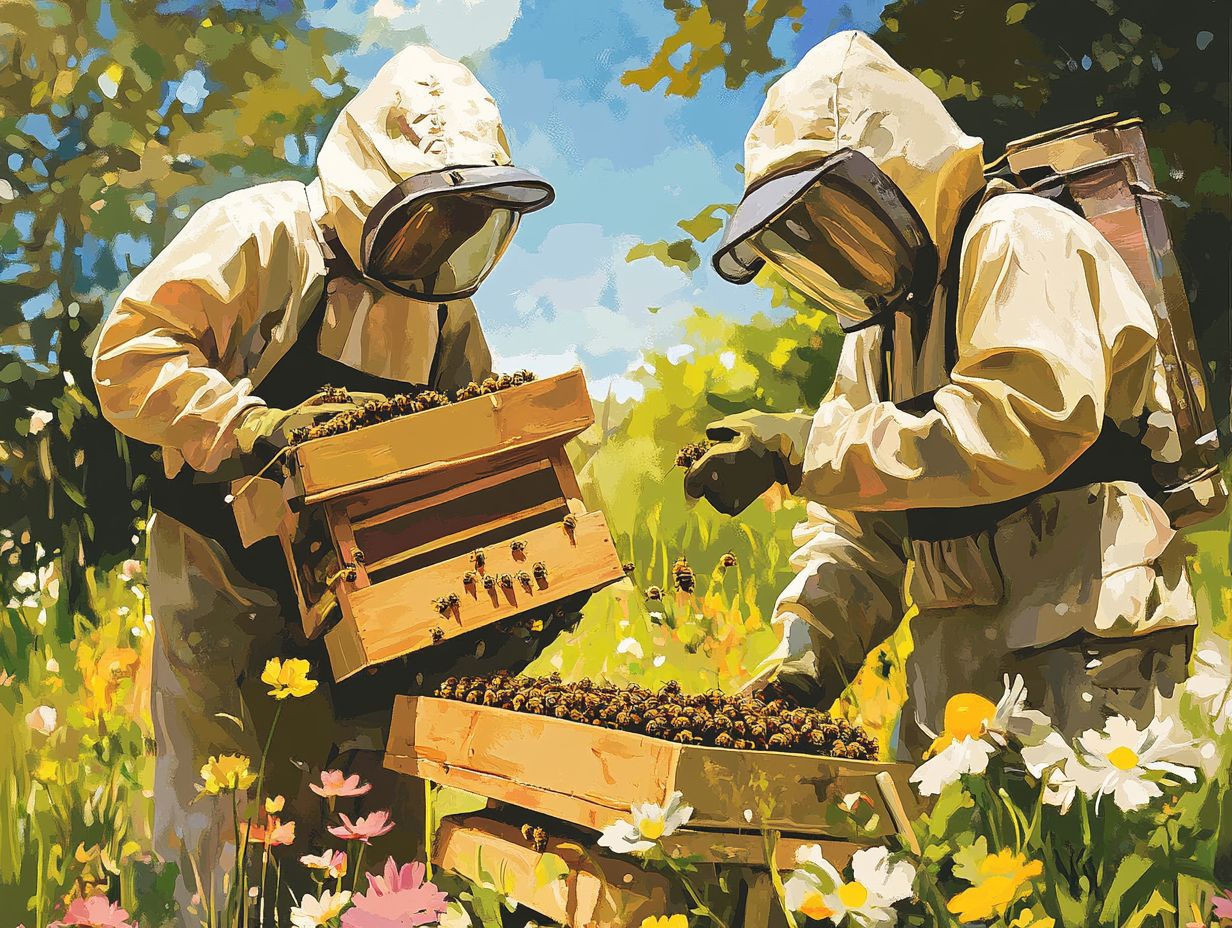
Controlling pests and diseases is paramount for promoting hive stability and ensuring the long-term health of your bee colonies. Particularly when it comes to managing Varroa mites, timely interventions during hive inspections can prevent significant disruptions in bee activity.
As a beekeeper, you should integrate pest management practices with proper nutrition and hive design to create a stable environment that nurtures robust bee populations and minimizes stressors affecting the hive.
Addressing issues like foulbrood and wax moths is just as crucial, as these threats can undermine the overall vitality of the colony. By implementing regular monitoring and preventive measures such as evaluating comb conditions and ensuring proper hive spacing to encourage ventilation you can significantly reduce the likelihood of infestations. Creating a stable platform for your hives will also minimize risks associated with pests.
Utilizing natural pest deterrents and incorporating beneficial organisms into your hive ecosystem can enhance your bees’ resilience against diseases. Staying informed about the latest advancements in pest control methods and adopting a proactive approach is vital, as maintaining hive health directly influences pollination efficiency and honey production.
4. Providing Adequate Ventilation
Adequate ventilation in your hive is crucial for creating a stable environment. This fosters healthy bee activity and prevents heat and moisture buildup during sweltering summer days.
Excess heat and humidity can stress your bees and disrupt their behavior. By prioritizing proper ventilation, you significantly contribute to the stability and resilience of your colonies, ultimately boosting honey production.
Effective ventilation is also key to managing humidity levels. High humidity can lead to mold growth and other harmful conditions that threaten your bees’ well-being. Consider integrating adjustable vents into your hive structure; this allows you to optimize airflow and adapt it according to the changing seasons.
Using hive designs with screened bottom boards enhances airflow while also mitigating the risk of pests. By monitoring internal hive conditions with tools like hygrometers, you gain valuable insights. This enables you to make informed decisions about when and how to adjust your ventilation systems, ensuring the health and vitality of your bees.
5. Managing Population Size
Managing the population size within a bee colony is crucial for maintaining hive stability. This helps prevent issues like queen supersedure (when bees replace an old queen with a new one) or absconding.
You should closely monitor bee activity and take appropriate actions to balance the population, especially during peak seasons. This proactive approach helps mitigate stress factors that can destabilize the hive and ensures a healthy environment for continuous honey production.
To navigate these dynamics effectively, implement various monitoring techniques, such as regular hive inspections and digital hive monitoring systems. These tools empower you to assess bee health, population density, and overall activity levels.
When you notice a high population density, interventions like splitting hives or introducing new queens can help maintain balance. Additionally, using foundationless frames can encourage natural comb building and stabilize population growth.
By understanding the natural behaviors and cycles of your bees, you can take timely actions that promote long-term colony health. This ultimately enhances the sustainability of your honey production efforts.
6. Minimizing Stress Factors
Minimizing stress factors for your bees is essential for promoting hive stability. This ensures that your colonies thrive.
Pay close attention to environmental changes that might impact bee activity, such as temperature fluctuations and habitat disturbances. Adopt proper handling techniques during inspections to create a calm and stable environment.
Physical disturbances are not the only concern. Factors like pesticide exposure and inadequate forage can seriously undermine the health of your bee colonies. Understand how these variables affect your bees, and implement effective strategies.
Selecting pest-resistant crops and ensuring a diverse array of flowering plants is readily available can make a big difference. Employing different types of hive stands, such as commercial or DIY hive stands, can help mitigate some environmental stressors.
Practice proper hive management by regularly assessing bee populations, conducting frame inspections, and monitoring for diseases. These actions are crucial for fostering a robust bee community.
Taking proactive measures against potential stressors sustains the integrity of your hive. This also promotes long-term ecological balance and successful pollination efforts.
What Are the Signs of an Unstable Hive?
Recognizing the signs of an unstable hive is essential for you as a beekeeper dedicated to maintaining robust bee colonies. Look for indicators such as decreased honey production, heightened aggression among your bees, or occurrences of queen supersedure or absconding these all signal potential issues that could jeopardize the stability of your hive.
Ensuring proper hive height and stable platforms can help mitigate some of these instability factors. Stay alert! Spotting these signs quickly lets you take swift action, restoring stability and safeguarding the well-being of your colonies.
1. Decreased Honey Production
Decreased honey production often serves as one of the first indicators that your hive may be unstable. This points to potential issues in bee activity or environmental conditions. Factors such as stress from pests, diseases, or improper hive management can significantly impact foraging behavior, leading to reduced honey yields. As a beekeeper, you must watch your honey production closely to identify any irregularities that may signal a need for intervention to restore stability within the hive.
To truly grasp the dynamics of honey production, it’s essential to consider how external variables like climate fluctuations, floral availability, and the introduction of new colonies can influence the overall health of your hive. For instance, a sudden change in temperature can drastically affect bee activity. Therefore, it’s crucial for you to adjust your management strategies accordingly. Tools like digital hive sensors and adjustable platforms can aid in monitoring and adapting to these changes efficiently.
Regularly checking hive conditions, including signs of bugs that harm the bees or nutritional deficiencies, allows you to proactively address issues before they escalate. Embracing modern tools, such as digital hive sensors and tracking apps, will enhance your monitoring efforts and enable you to make data-driven decisions that foster a thriving honey production environment. Maintaining drawn comb also helps manage your hive efficiently.
2. Increased Aggression in Bees
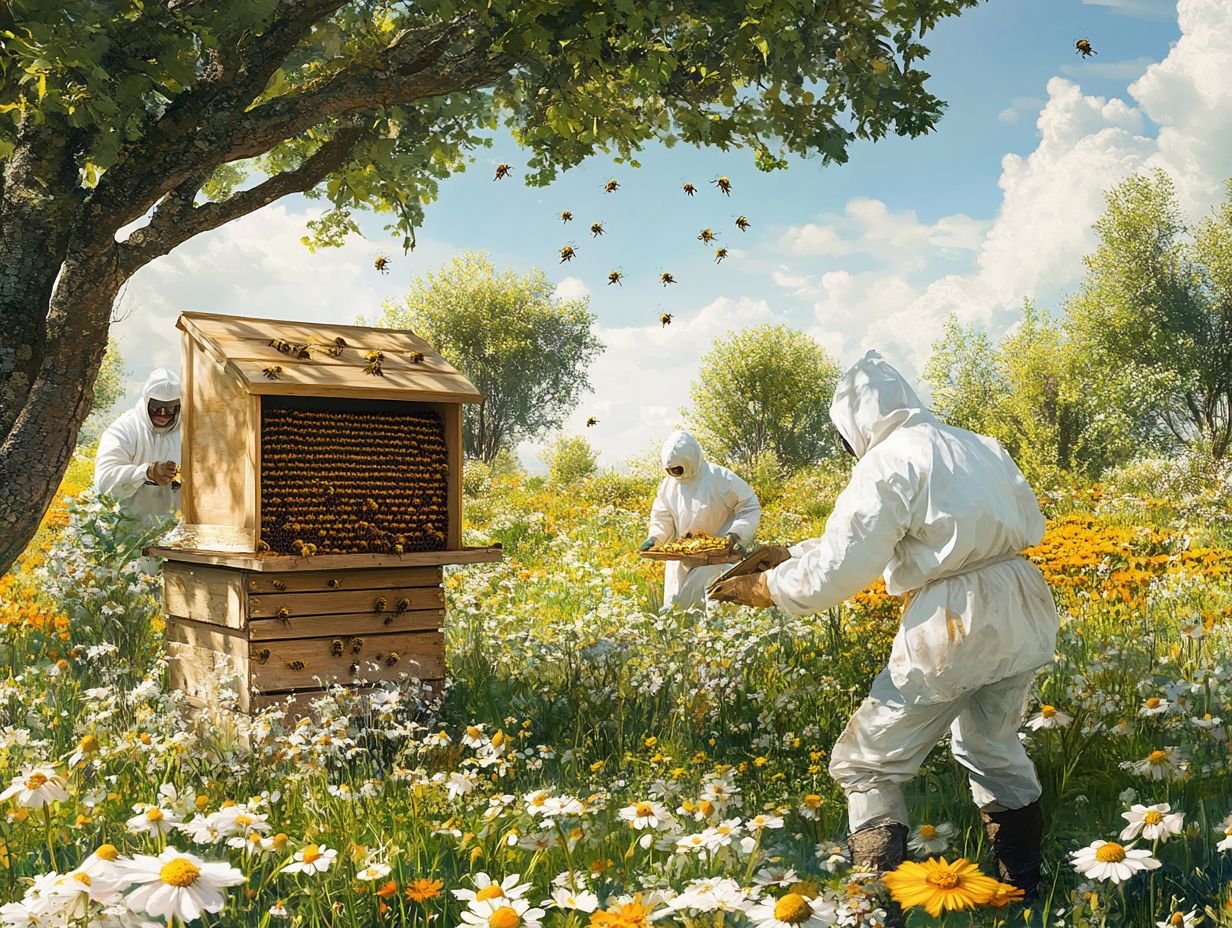
Increased aggression among your bees can be a telling sign of an unstable hive, often triggered by stressors such as overcrowding, pest infestations, or improper hive handling. Stay vigilant to changes in their behavior; heightened aggression might suggest that the colony feels threatened or stressed. You must address the root causes of bee aggression to promote harmony and stability in your hive.
Recognizing the connection between hive conditions and aggressive behavior will significantly enhance your approach to managing your colonies. For instance, making minor adjustments like ensuring there’s enough space for your bees to thrive and keeping an eye out for pests like Varroa mites can greatly reduce stress within the colony. Regular inspections, using hive rails, and employing gentle hive management techniques can also help soothe overt aggression.
Understanding how environmental changes such as temperature shifts or forage availability affect bee behavior will enable you to create more supportive conditions. Ultimately, maintaining a stable hive environment safeguards the well-being of your bees and boosts the success of your honey production and pollination efforts. Considering different hive designs and ensuring a stable platform for your hives are important factors in maintaining stability.
Key Takeaway: Address the root causes of aggression to create a harmonious environment for your bees!
3. Queen Supersedure or Absconding
Queen supersedure or absconding are serious indicators of an unstable hive, revealing potential issues with the health of your colony or environmental stressors. When you notice a queen being superseded, it disrupts the stability of your hive. Meanwhile, absconding suggests that your bees are leaving due to unfavorable conditions.
It s essential to address these situations promptly to restore stability and safeguard the survival of your colonies.
Understanding the implications of these events is crucial for maintaining a thriving hive. When the queen is replaced, it often signals underlying problems, such as pests that harm the bees or inadequate resources, which can compromise the reproductive output and overall vitality of your colony.
On the flip side, absconding can occur in response to excessive heat, humidity, or lack of food, leading to significant losses if not addressed swiftly.
To mitigate these issues, you should regularly inspect your hives, maintain optimal conditions, and offer supplemental feeding during droughts or times of scarcity. Implementing these preventative measures is vital for enhancing your hive s resilience and ensuring a fruitful beekeeping experience.
Key Takeaway: Act quickly to resolve these issues and protect your bees!
How Can You Help a Struggling Hive?
When faced with a struggling hive, prompt action and strategic decisions are essential for restoring stability and fostering healthy colony growth.
You may consider employing various methods, such as:
- supplemental feeding to supply the necessary nutrients, like sugar syrup during times of scarcity,
- re-queening to maintain a robust genetic line,
- splitting the hive when populations become unwieldy.
In certain situations, combining weaker hives can also serve as an effective strategy to enhance overall hive stability and productivity. Maintain a stable platform and ensure the hive height is appropriate to enhance feeding effectiveness.
1. Supplemental Feeding
Supplemental feeding is a powerful strategy to enhance hive stability and support bee activity, especially during times when resources are scarce. By providing sugar syrup or other nutrient sources, you can ensure that your colonies receive the nutrition they need when foraging opportunities dwindle. This practice helps prevent stress factors that could compromise the health and productivity of your hives.
Timing is key; it s most effective during critical periods like late winter or early spring, when natural food sources are in short supply. You can employ various methods, such as hive-top feeders or entrance feeders, tailored to the specific needs of your bees while keeping disturbances to a minimum.
By managing your feeding strategies carefully, you not only mitigate the risks linked to inadequate nutrition but also bolster the resilience of your colonies. This way, your hives can thrive and flourish, even in the face of seasonal challenges.
2. Re-queening
Re-queening is an essential step in maintaining the stability of your hive, especially if you notice your queen showing signs of poor health or inadequate egg-laying. A healthy queen is crucial for driving colony growth and encouraging lively bee activity. By introducing a new queen, you can breathe new life into the hive and restore its vitality, promoting overall stability within the colony.
Don t wait too long to replace a struggling queen; doing so can make a huge difference for your hive. Look for signs like reduced brood production, erratic behavior among the bees, or the appearance of supersedure cells; these often indicate that the queen is no longer fulfilling her role effectively. Using a small beehive can help in the process of re-queening.
Bringing in a new queen can dramatically boost your hive s productivity by improving egg-laying rates and enhancing overall colony dynamics. A vigorous queen not only fosters better foraging efficiency but also strengthens the hive s defenses against pests and diseases.
While the process requires careful planning and execution, it ultimately cultivates a more stable and prosperous environment where your bees can truly thrive.
3. Splitting the Hive
Splitting the hive is a strategic approach that you can use to manage population size and promote stability within your colonies, especially when they become overcrowded. By dividing a strong colony, you have the opportunity to create two productive hives while effectively balancing resource allocation. This not only alleviates stress but also enhances the overall health of each hive. Embracing this method fosters stability and boosts your honey production potential.
Timing is key; spring is the best season for hive splits, as foraging is at its peak and the queen is actively laying eggs. Before you proceed, take the time to assess the colony’s strength, ensuring that there are ample resources like pollen and nectar available. You’ll also want to select a queen cell or create a nucleus colony to set things in motion. Utilizing foundation-filled frames can also aid in successful hive splits.
You can expect many benefits from this practice: a healthier bee population, reduced tendencies for swarming, and increased honey yields. With meticulous planning, these newly formed colonies can flourish, contributing to sustainable beekeeping that benefits both your bees and your beekeeping endeavors. The beekeepers can also ensure better hive stability by maintaining the best hive conditions.
Summary of Strategies:
- Prompt action and strategic decisions.
- Supplemental feeding during resource scarcity.
- Re-queening a struggling hive.
- Splitting hives to manage population size.
Take these steps today to ensure your bees thrive and your honey production flourishes!
4. Combining Weak Hives

Combining weak hives can be a savvy approach to enhancing hive stability and ensuring the survival of struggling bee colonies. This method can also optimize beekeeping activities like hive inspections and honey production. By merging weaker hives, you facilitate resource sharing and bolster colony health, alleviating stress on both groups. To ensure the hive stability, you can use Polystyrene nucs or foundation-filled frames. This method not only strengthens the surviving hive but also boosts overall productivity, making it an essential strategy for effective hive management.
It’s important to implement this method under specific conditions, such as during times of resource scarcity or when one colony is showing signs of declining populations due to disease or environmental factors. Before you proceed, carefully assess the health of each colony, ensuring that the stronger hive is free from pests and pathogens. Consider using bee suit and hive tool during inspections for safety and efficiency.
To execute this method effectively, begin by preparing the stronger hive to welcome new members. Consider using nucleus beehive or foundationless frames to create an optimal environment. This may involve creating additional space by removing supers or adding frames. Ensure proper hive entrance and maintain a stable platform to support the new hive structure. Then, gently introduce the weaker bees, allowing them to acclimate before fully integrating the two groups. Use sugar syrup to feed the new bees and ensure the hive is on a horizontal surface to avoid instability. Keep a close eye on the combined hive in the following weeks to ensure that the bees adapt well and maintain a harmonious environment. Utilize adjustable platform and scaffold jacks to manage the hive height and provide additional working space.
Frequently Asked Questions
What is hive stability and why is it important?
Hive stability refers to maintaining a healthy and strong bee colony within a hive. It is important for the survival of the bees and for successful honey production.
How can I check the stability of my hive?
Check for balanced frames and ensure no vegetation blocking the hive entrance.
Check for balanced frames and ensure no vegetation blocking the hive entrance.
Some signs of a stable hive include a large population of bees, healthy brood pattern, and plentiful honey and pollen reserves. Regular frame inspections and hive inspections can help you assess the stability of your hive.
What are some ways to promote hive stability?
Ensuring secure assembly of the hive can also promote stability.
Ensuring secure assembly of the hive can also promote stability.
One way is to provide a suitable and consistent habitat for the bees, including access to food sources and protection from extreme weather conditions. Regular maintenance and pest control can also help promote hive stability.
What should I do if I notice signs of instability in my hive?
Consider using commercial hive stands or DIY hive stands to stabilize the hive.
Consider using commercial hive stands or DIY hive stands to stabilize the hive.
If you notice a decline in bee population or other signs of instability, it is important to take action immediately. This may include adding supplemental food like sugar syrup or treating for pests or diseases.
How can I prevent hive collapse?
Ensure that the hive is built on damp ground to maintain humidity and avoid top heavy structures.
To prevent hive collapse, it is crucial to maintain a clean and hygienic hive, regularly monitor for pests and diseases, and provide adequate nutrition for the bees. It is also important to avoid overworking the bees by taking too much honey or adding new hive components too quickly. Using Galvanized steel or wooden rails can support the hive structure.
Are there any natural methods for promoting hive stability?
Using foundation or drawn comb can also support natural hive stability.
Yes, there are natural methods such as planting bee-friendly flowers and herbs like orchids and rhododendron, avoiding the use of pesticides, and providing a diverse range of pollen and nectar sources. Encouraging natural behaviors, such as swarming and brood breaks, can also help maintain a stable hive.

